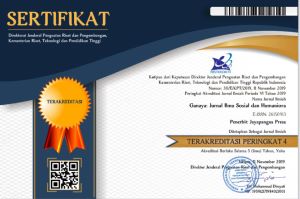Pasang Surut Kerajinan Patung Kayu Pada Industri Pariwisata Di Desa Batubulan Kangin
DOI:
https://doi.org/10.37329/ganaya.v4i2.1400Keywords:
Pasang Surut, Kerajinan Patung Kayu, Industri PariwisataAbstract
The wooden sculpture craft in Batubulan Kangin Village began in 1968. The learning process was more than twenty people, and took place in Guang Village. In 1970, after they were proficient at making sculptures, they taught their villages starting with statues of Garuda, Ramayana and others. These crafts have marketing opportunities and motivate craftsmen to increase their creativity. When there was the first Bali bombing, and the globalization market, these crafts experienced a decline. Based on that, the problems were posed, namely: How is the process of realizing wooden sculptures, what products are produced, and how are the ebb and flow of wooden sculptures in Batubulan Kangin Village. The purpose of this study was to describe the ebb and flow of wooden sculpture in the tourism industry in Batubulan Kangin Village. This study uses data collection techniques carried out by observation, interviews and document studies. Data analysis was carried out with a qualitative approach, based on aesthetic theory and social change. The results of this study are the process of realizing wooden sculptures starting from the exploration of ideas, shapes, selection of materials, tools, work processes and finishing. The products produced are statues of Garuda Wisnu, Rama Shinta, Hanoman, Chinese Dragon, Kwan Im, Toa Pe Kong, Buddha, Barong, Rangda, Saraswati, Sri, Durga, Lord Shiva, Ganesha and Kwan Sing Tee Koen statues. The ups and downs of wooden sculpture can be seen from 1970. In that year there were about twenty people who were skilled at making sculptures and developing them, for example the statue of Garuda, Ramayana, and others. The existence of these crafts, has marketing opportunities and motivates craftsmen to increase their creativity. When the first Bali bombing occurred, the globalization market, and the corona virus, these crafts experienced a decline, but craftsmen continued to produce these crafts.
References
Anonim. (1988), Monografi Desa Batubulan Kangin, Gianyar: LKMD Desa Batubulan Kangin.
Fajri, Em Zul dan Ratu Aprilia Senja. (tt), Kamus Lengkap Bahasa Indonesia, Jakarta: Difa Publisher.
Gustami SP. (2007), Butir-Butir Mutiara Estetika, Yogyakarta: Prasista.
Moleong, Lexy J. (1995), Metode Penelitian Kualitatif, Yogyakarta: Rake Sarasin.
Sugiono, (2011), Metode Penelitian Pendidikan Pendekatan Kuantitatif, Kualitatif, dan R&D, Bandung: Alfabeta.
Suardana, I Wayan. dkk. (2014), Terpuruknya Seni Kerajinan Di Gianyar Bali Dalam Pasar Global: Laporan Penelitian Fundamental Institut Seni Indonesia Denpasar.
Tan Herman, 2016, Ajaran Welas Asih Dewi Kwan Im. http://www.tionghoa.info, diakses tanggal 10 Juni 2020.
Yoswara, Harry Pujianta. dkk, (2011), Simbol Dan Makna Bentuk Naga Studi Kasus: Vihara Satya Budhi Bandung, journal.itb.ac.id., di akses tanggal 26 Agustus 2020.
Downloads
Published
How to Cite
Issue
Section
License
An author who publishes in the Ganaya : Jurnal Ilmu Sosial dan Humaniora agrees to the following terms:
- Author retains the copyright and grants the journal the right of first publication of the work simultaneously licensed under the Creative Commons Attribution-ShareAlike 4.0 License that allows others to share the work with an acknowledgement of the work's authorship and initial publication in this journal
- Author is able to enter into separate, additional contractual arrangements for the non-exclusive distribution of the journal's published version of the work (e.g., post it to an institutional repository or publish it in a book) with the acknowledgement of its initial publication in this journal.
- Author is permitted and encouraged to post his/her work online (e.g., in institutional repositories or on their website) prior to and during the submission process, as it can lead to productive exchanges, as well as earlier and greater citation of the published work (See The Effect of Open Access).
Read more about the Creative Commons Attribution-ShareAlike 4.0 Licence here: https://creativecommons.org/licenses/by-sa/4.0/.








